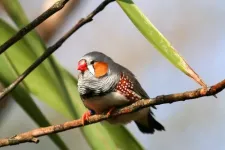(Press-News.org) The 2019-2020 flu season in the U.S. was unusual in a number of ways. Cases picked up in August rather than the more typical fall and early winter months, and it hit children particularly hard. It was also dominated early on by a Type B influenza virus instead of one of the much more common Type A viruses like H1N1 or H3N2.
A new study by researchers at the University of Georgia suggests that these dynamics were driven largely by a new, more transmissible strain encountering a population with very little existing immunity to it.
Their findings, just published in the Proceedings of the National Academy of Sciences, have implications for future vaccination and preparedness strategies.
"Influenza B viruses until now have been thought of as the junior partner in this endeavor, and what our paper demonstrates is that, in the 2019-2020 flu season, they were in fact the senior partner in the U.S. flu epidemic," said Pejman Rohani, Regents' and Georgia Athletic Association Professor in the Odum School of Ecology and College of Veterinary Medicine, the paper's senior author.
Rohani, lead author Rebecca Borchering, and their colleagues used a combinatioFINAn of mechanistic transmission models and likelihood-based statistical inference to test potential explanations for the 2019-2020 season's unusual dynamics.
"That's one way to see whether or not a proposed hypothesis fits in with the observed patterns," said Borchering, at the time of the study a postdoctoral associate working with Rohani. She is now at Penn State University.
One hypothesis involved within-host interactions between different viruses, in which the immune response to one virus prevents the other from gaining a foothold; studies have suggested that such interference may be possible even across virus types if the exposures happen within a short enough time. They created one model to test that assumption.
Another possibility was that the genetic mutations that distinguished the 2019-2020 virus strain--known as "B/Victoria subclade V1A.3"--had made it more easily transmissible, as the mutations occurred on two genes that are involved in triggering the immune response. The team built a second model to test that premise.
They then compared the results of both models to see which most closely resembled the pattern observed in the actual outbreak data.
"We arrived at the explanation that it really was increased transmissibility of this novel variant, and at the same time the fact that the susceptible population, the population of individuals naïve to this virus, was larger than you would expect, which led to the dynamics that we see," said Rohani.
One reason for the larger than usual number of people susceptible to the V1A.3 variant was that the previous year's flu season was almost entirely the result of Type A influenza viruses, rather than a mix of A and B. People who've been infected by a Type A virus generally gain some immunity to related Type A viruses, but not to Type B viruses, while those previously infected by a Type B virus are likewise somewhat protected from other Type B viruses but not from Type A.
"That's where age starts to come into it a bit," said Borchering. "In the paper, we mention younger individuals were more severely affected [in 2019-2020] and that's likely related to them having less time to be infected by other B viruses."
Rohani and Borchering said that their findings pointed to the need to learn more about Type B influenza viruses and incorporate that knowledge into vaccine development and timing strategies.
"Our study suggests it's important to keep an eye on the evolution of influenza B to avoid a vaccine mismatch in the same way they do with H3N2," Rohani said, explaining that vaccine updates are based on predictions about what's likeliest to be the next year's H3N2 variant.
"Anticipating the timing of influenza A and influenza B epidemics could improve vaccination schedules, so that individuals have protection throughout the influenza season."
Borchering said the team's findings also point to the need for enhanced surveillance for influenza beyond the winter months, and that hospitals may want to consider ensuring that they are prepared for an influx of flu patients earlier than usual.
Another factor to consider is how steps taken to curtail COVID-19 transmission may affect future flu seasons.
"Measures trying to restrict transmission of SARS-CoV-2 prevent transmission of other respiratory viruses too--it's not like you get to pick which virus you transmit," said Borchering. "It's unclear what exactly will happen, but there has been a very small influenza season this year. People aren't getting the exposures they would normally get during flu season. Fewer exposures lead to fewer infections, and thus fewer individuals acquiring immunity. This could lead to large influenza epidemics in the future, particularly when combined with relaxation of COVID-19 prevention measures, such as social distancing and mask wearing."
INFORMATION:
The study's co-authors are Christian E. Gunning, Deven V. Gokhale, K. Bodie Weedop, Arash Saeidpour and Tobias S. Brett. It was supported by the National Institutes of Health through the Models of Infectious Disease Agent Study Project, award number R01GM123007.
A new white paper from The Gerontological Society of America (GSA) highlights the variety of challenges that persons with dementia-related psychosis and their caregivers have encountered during moves through different health care settings -- and proposes strategies to address these challenges.
It is estimated that over 2 million Americans with dementia experience delusions (false beliefs) and hallucinations (seeing or hearing things that others do not see or hear). This group of symptoms, known as dementia-related psychosis, frequently goes undetected in people who may ...
NEWPORT, Ore. - Researchers can now determine the age and sex of living beluga whales in Alaska's Cook Inlet thanks to a new DNA-based technique that uses information from small samples of skin tissue.
Accurate age estimates are vital to conservation efforts for Cook Inlet belugas, which were listed as endangered following a significant population decline in the 1990s. Previously, researchers could only determine the age of beluga whales by studying the teeth of dead animals.
The new aging method uses DNA methylation data and machine learning to develop a model that captures ...
If you have a second, try typing "time management" into your favourite search engine.
You will get literally millions of results: books, tips, lessons, do's and don'ts.
It's a big industry. But as END ...
A new analysis of a horse previously believed to be from the Ice Age shows that the animal actually died just a few hundred years ago--and was raised, ridden and cared for by Native peoples. The study sheds light on the early relationships between horses and their guardians in the Americas.
The findings, published today in the journal American Antiquity, are the latest in the saga of the "Lehi horse."
In 2018, a Utah couple was doing landscaping in their backyard near the city of Provo when they unearthed something surprising: an almost complete skeleton of a horse about the size of a Shetland pony. Scientists and the media took note. Preliminary data suggested ...
For a girl in Ethiopia, her mother's wealth can protect her from becoming a child bride - but if a father prefers child marriage, his own wealth may increase the likelihood that she will be married before 18, according to a Rutgers University-New Brunswick study.
Published in the journal World Development, the study found that girls whose mothers have more asset holdings - a cellphone, bicycle, sewing machine, jewelry or other valuables - have a reduced rate of entering into a child marriage, while the rate is higher for girls whose fathers have more asset holdings.
"Child marriage is concerning from a human rights, health and economic perspective," said the study's author Felix Muchomba, assistant professor at the Rutgers School of Social Work. "Girls married before ...
Getting children to eat their vegetables can seem like an insurmountable task, but nutrition researchers at The University of Texas at Austin have found one way: school gardens and lessons on using what's grown in them.
Researchers worked with 16 elementary schools across Central Texas to install vegetable gardens and teach classes to students and parents about nutrition and cooking. In a study recently published in the END ...
Humans, wildlife, and the environment are all interconnected and play a role in one another's health and well-being. Sentinel species, such as birds, are good indicators of environmental health, and they can send subtle warning signs that humans may be in danger next.
In an experimental exposure study, Kendra Sewall, an associate professor of biological sciences in the College of Science, and a diverse team of scientists and students have found that lead levels like those reported in Flint, Michigan, can interfere with the neural mechanisms of vocal development of songbirds and affect mate attraction.
By examining the effects of lead exposure ...
Floating sea macro-litter is a threat to the conservation of marine ecosystems worldwide. The largest density of floating litter is in the great ocean gyres -systems of circular currents that spin and catch litter- but the polluting waste is abundant in coastal waters and semi closed seas such as the Mediterranean.
MARLIT, an open access web app based on an algorithm designed with deep learning techniques, will enable the detection and quantification of floating plastics in the sea with a reliability over 80%, according to a study published in the journal Environmental Pollution and carried out by experts ...
A new study led by the University of Kent's Durrell Institute of Conservation and Ecology (DICE) has found that elephants living around the world-famous Masai Mara National Reserve, Kenya, are crop-raiding closer to the protected area, more frequently and throughout the year but are causing less damage when doing so.
Findings show that the direct economic impact of this crop-raiding in the Trans Mara region has dropped, yet farmers have to spend more time protecting their fields, further reducing support for conservation in communities who currently receive few benefits from living with wildlife.
The research published by Biological Conservation ...
BUFFALO, N.Y. -- All things being equal, large, long-lived animals should have the highest risk of cancer.
The calculation is simple: Tumors grow when genetic mutations cause individual cells to reproduce too quickly. A long life creates more opportunities for those cancerous mutations to arise. So, too, does a massive body: Big creatures -- which have many more cells -- should develop tumors more frequently.
Why, then, does cancer rarely afflict elephants, with their long lifespans and gargantuan bodies? They are some of the world's largest land animals.
A new study delves into this ...





